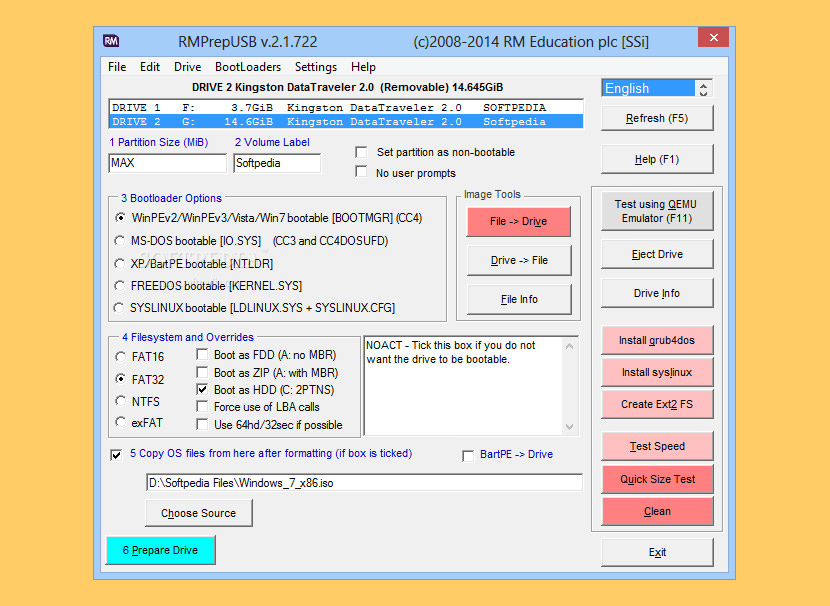

- #Make a windows 98 usb installer no cd#
- #Make a windows 98 usb installer install#
- #Make a windows 98 usb installer drivers#
- #Make a windows 98 usb installer Pc#
- #Make a windows 98 usb installer iso#
Copied himem.sys to the C: drive, in the root directory Copied smartdrv.exe to the C: drive, in the root directory Ran smartdrv.exe a second time to show the stats and verify it was operational Ran smartdrv.exe off the SD card to get it running
#Make a windows 98 usb installer install#
Formatted the "drives" using, but as soon as that was done I issued the sys c: command to install system files on C: and make it bootable, then I tested that to make sure the laptop would boot off just the hard drive direct to a C: prompt, then rebooted again off the SD card Ran fdisk and created an 8GB (literally 8000 MB, not 8192 MB) FAT32 Primary partition and then a 4GB Extended partition with a 4GB Logical drive, also FAT32, rebooted to make the partition changes effective
#Make a windows 98 usb installer no cd#
Chose the no CD boot option so himem.sys and the other files load properly Inserted the SD card and booted the laptop from the card I placed smartdrv.exe on the root of the SD card I placed that file on a 1GB microSD card inside an SD card adapter, then I copied the necessary installation files direct from the two XP Tablet Edition 2005 CDs into two folders named CD1 and CD2 respectively ima) becomes a "virtual floppy" for this device. So the entire bootable floppy image file (the. Toshiba created the special filename of $TOSFD00.VFD to stand for $TOShiba Floppy Disk 00.VirtualFloppyDrive for some odd reason. ima file it contained and rename that win98se.ima file to $TOSFD00.VFD - I didn't have to do anything else to it.

Find a 98SE boot disk (from - Download the file, extract the. What I had to do to get XP Tablet Edition 2005 on it was:
#Make a windows 98 usb installer Pc#
I have a Toshiba Tablet PC here (m205-s810) that has no internal optical drive, has no boot capability from the USB 2.0 ports either, but it does boot from the SD card reader - yes, it's kinda fucked up that way and I have no idea why Toshiba did that. Without it, the file copy process alone can take over 30 mins, sometimes a lot longer depending on the source material speed (if it's CD, it'll be excruciatingly slow, faster devices obviously get it done faster but still slow because there's no read/write caching going on). You don't NEED to run smartdrv.exe to install an NT-based OS like 2K or XP, but because of how much time you'll save it's usually recommended.

NT-based OSes don't use it, but during the text mode portion of NT-based OSes - where all that damned file copying goes on - is where it benefits the most. Nope, it's not "in there" as you'll need to find it. Search for: Forgot your Windows or Mac password? Can't login? Try kon-boot. No USB access, WiFi, Bluetooth, Ethernet, etc. DOS can get very confused about large hard disks and systems with large RAM memory! Even if you manage to get it installed, you will probably not be able to run a browser or get audio working. They will therefore only run on very old systems with small IDE hard drives (or BIOS configured for Legacy IDE) and less than 1GB of RAM. imgPTN file using the MPI Tool Kit to make a bootable DOS partition. See RMPrepUSB Tutorial 117 and see blog post here.
#Make a windows 98 usb installer iso#
It is best to remove some unneeded files from the Win98 ISO before using it to reduce the size of the ISO. isoDOS01 file extension – once booted from Easy2Boot, the CD files will be on the B: drive. YT video for Win98 onto an HP Compaq t5710 thin client here.

Installing Linux from an ISO file onto a system.MBR-boot from a Debian\Kali ISO with persistence.Ubuntu-based ISO + persistence (.isopersist).
#Make a windows 98 usb installer drivers#


 0 kommentar(er)
0 kommentar(er)
